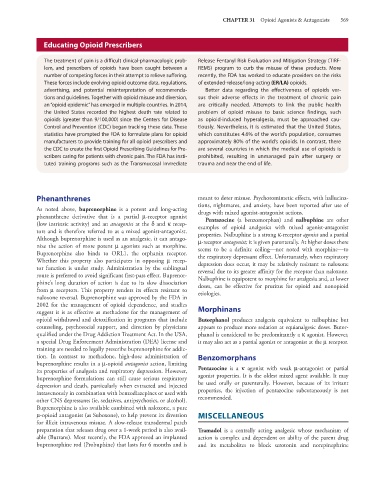Page 583 - Basic _ Clinical Pharmacology ( PDFDrive )
P. 583
CHAPTER 31 Opioid Agonists & Antagonists 569
Educating Opioid Prescribers
The treatment of pain is a difficult clinical-pharmacologic prob- Release Fentanyl Risk Evaluation and Mitigation Strategy (TIRF-
lem, and prescribers of opioids have been caught between a REMS) program to curb the misuse of these products. More
number of competing forces in their attempt to relieve suffering. recently, the FDA has worked to educate providers on the risks
These forces include evolving opioid outcome data, regulations, of extended-release/long-acting (ER/LA) opioids.
advertising, and potential misinterpretation of recommenda- Better data regarding the effectiveness of opioids ver-
tions and guidelines. Together with opioid misuse and diversion, sus their adverse effects in the treatment of chronic pain
an “opioid epidemic” has emerged in multiple countries. In 2014, are critically needed. Attempts to link the public health
the United States recorded the highest death rate related to problem of opioid misuse to basic science findings, such
opioids (greater than 9/100,000) since the Centers for Disease as opioid-induced hyperalgesia, must be approached cau-
Control and Prevention (CDC) began tracking these data. These tiously. Nevertheless, it is estimated that the United States,
statistics have prompted the FDA to formulate plans for opioid which constitutes 4.6% of the world’s population, consumes
manufacturers to provide training for all opioid prescribers and approximately 80% of the world’s opioids. In contrast, there
the CDC to create the first Opioid Prescribing Guidelines for Pre- are several countries in which the medical use of opioids is
scribers caring for patients with chronic pain. The FDA has insti- prohibited, resulting in unmanaged pain after surgery or
tuted training programs such as the Transmucosal Immediate trauma and near the end of life.
Phenanthrenes meant to deter misuse. Psychotomimetic effects, with hallucina-
tions, nightmares, and anxiety, have been reported after use of
As noted above, buprenorphine is a potent and long-acting drugs with mixed agonist-antagonist actions.
phenanthrene derivative that is a partial μ-receptor agonist Pentazocine (a benzomorphan) and nalbuphine are other
(low intrinsic activity) and an antagonist at the δ and κ recep- examples of opioid analgesics with mixed agonist-antagonist
tors and is therefore referred to as a mixed agonist-antagonist. properties. Nalbuphine is a strong κ-receptor agonist and a partial
Although buprenorphine is used as an analgesic, it can antago- μ-receptor antagonist; it is given parenterally. At higher doses there
nize the action of more potent μ agonists such as morphine. seems to be a definite ceiling—not noted with morphine—to
Buprenorphine also binds to ORL1, the orphanin receptor. the respiratory depressant effect. Unfortunately, when respiratory
Whether this property also participates in opposing μ recep- depression does occur, it may be relatively resistant to naloxone
tor function is under study. Administration by the sublingual reversal due to its greater affinity for the receptor than naloxone.
route is preferred to avoid significant first-pass effect. Buprenor- Nalbuphine is equipotent to morphine for analgesia and, at lower
phine’s long duration of action is due to its slow dissociation doses, can be effective for pruritus for opioid and nonopioid
from μ receptors. This property renders its effects resistant to etiologies.
naloxone reversal. Buprenorphine was approved by the FDA in
2002 for the management of opioid dependence, and studies
suggest it is as effective as methadone for the management of Morphinans
opioid withdrawal and detoxification in programs that include Butorphanol produces analgesia equivalent to nalbuphine but
counseling, psychosocial support, and direction by physicians appears to produce more sedation at equianalgesic doses. Butor-
qualified under the Drug Addiction Treatment Act. In the USA, phanol is considered to be predominantly a κ agonist. However,
a special Drug Enforcement Administration (DEA) license and it may also act as a partial agonist or antagonist at the μ receptor.
training are needed to legally prescribe buprenorphine for addic-
tion. In contrast to methadone, high-dose administration of Benzomorphans
buprenorphine results in a μ-opioid antagonist action, limiting
its properties of analgesia and respiratory depression. However, Pentazocine is a κ agonist with weak μ-antagonist or partial
buprenorphine formulations can still cause serious respiratory agonist properties. It is the oldest mixed agent available. It may
depression and death, particularly when extracted and injected be used orally or parenterally. However, because of its irritant
intravenously in combination with benzodiazepines or used with properties, the injection of pentazocine subcutaneously is not
other CNS depressants (ie, sedatives, antipsychotics, or alcohol). recommended.
Buprenorphine is also available combined with naloxone, a pure
μ-opioid antagonist (as Suboxone), to help prevent its diversion MISCELLANEOUS
for illicit intravenous misuse. A slow-release transdermal patch
preparation that releases drug over a 1-week period is also avail- Tramadol is a centrally acting analgesic whose mechanism of
able (Butrans). Most recently, the FDA approved an implanted action is complex and dependent on ability of the parent drug
buprenorphine rod (Probuphine) that lasts for 6 months and is and its metabolites to block serotonin and norepinephrine

